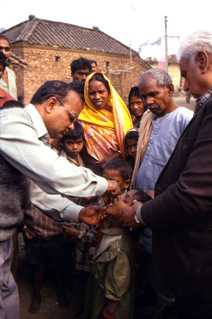The Global Push toward Worldwide Eradication

A local Indian public health care practitioner administering an oral polio vaccine dosage to a child in an outside setting, in one of the country's many villages. After being vaccinated, one of the child's fingers would be marked with an ink marker designating to other health care workers that he'd been vaccinated during the National Immunization Day campaign.
Launched in 1988, GPEI has been the largest public health initiative in history. At that time, more than 125 countries had widespread polio, with an estimated 350,000 children paralyzed by the disease annually – nearly 1,000 each day. The World Health Organization (WHO), Rotary International, CDC, UNICEF, and the Bill & Melinda Gates Foundation are all major partners in the initiative, with CDC serving as a lead technical partner.
GPEI’s four key strategies outlined by the World Health Organization for stopping polio transmission are:
- High infant immunization coverage with four doses of oral polio vaccine (OPV) in the first year of life in developing and countries where polio is still pervasive and routine immunization with OPV and/or IPV elsewhere.
- Organization of “national immunization days” to provide supplementary doses of oral polio vaccine to all children less than five years of age.
- Active surveillance for wild poliovirus through reporting and laboratory testing of all cases of acute flaccid paralysis among children less than fifteen years of age.
- Targeted "mop-up" campaigns once wild poliovirus transmission is limited to a specific focal area. For more about GPEI’s strategy to eliminate polio worldwide, see Global Polio Eradication Initiative Strategic Plan: 2004–2008.
Polio rates have dropped more than 99 percent since the launch of global polio eradication efforts in 1988, and no polio cases have been reported since January 2011 in India – one of the four remaining countries where it has continued. Nevertheless, poliovirus transmission is ongoing in other three countries – Afghanistan, Nigeria, and Pakistan, and travelers have carried the infection back to 39 previously polio-free countries over the last several years. Three of these countries – Angola, Chad, and Democratic Republic of the Congo – have continued to have transmission of poliovirus for more than one year, raising concerns that a window of opportunity to eradicate this crippling and sometimes deadly disease may be closing. It is therefore critical that we give this final push toward eradication our best effort. As Dr. Frieden has stated, “If we fail to get over the finish line, we will need to continue expensive control measures for the indefinite future…More importantly, without eradication, every year, polio could disable or kill more than 100,000 children.”
- Page last reviewed: March 19, 2014
- Page last updated: March 19, 2014
- Content source:


 ShareCompartir
ShareCompartir